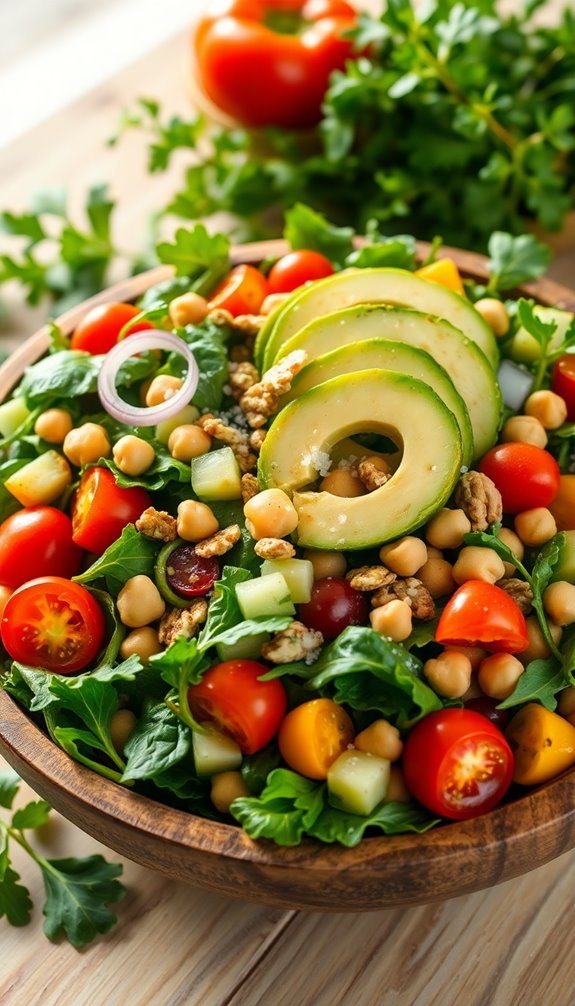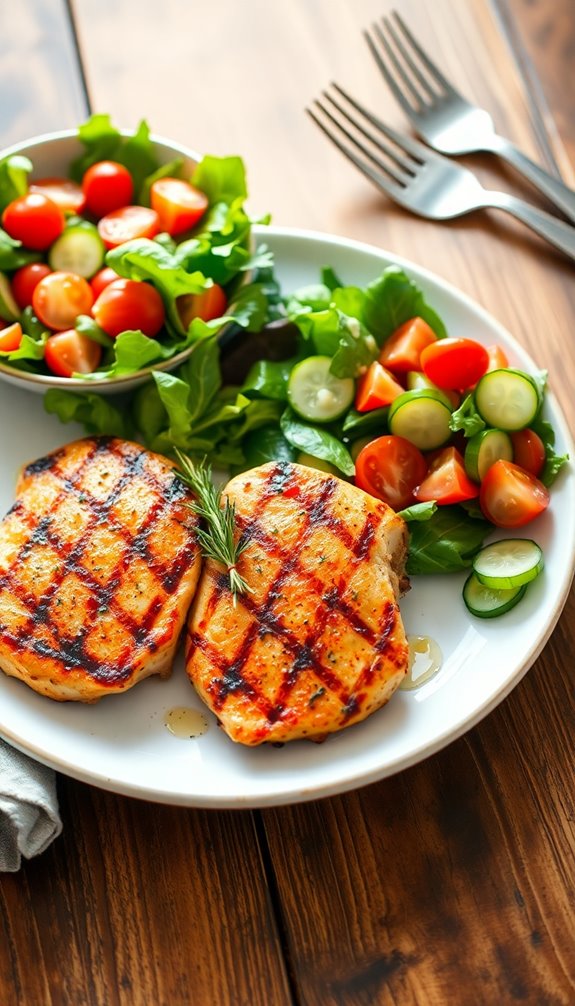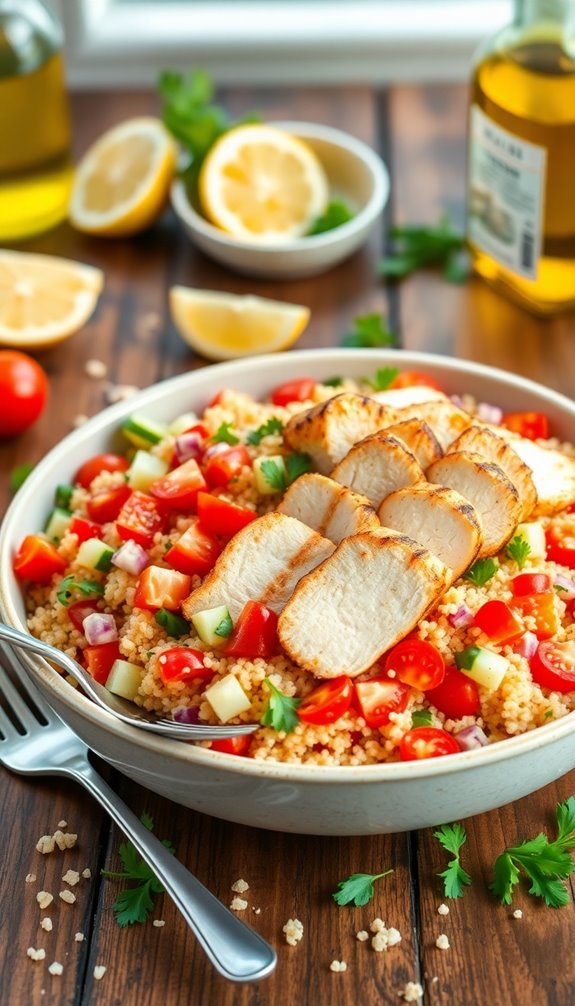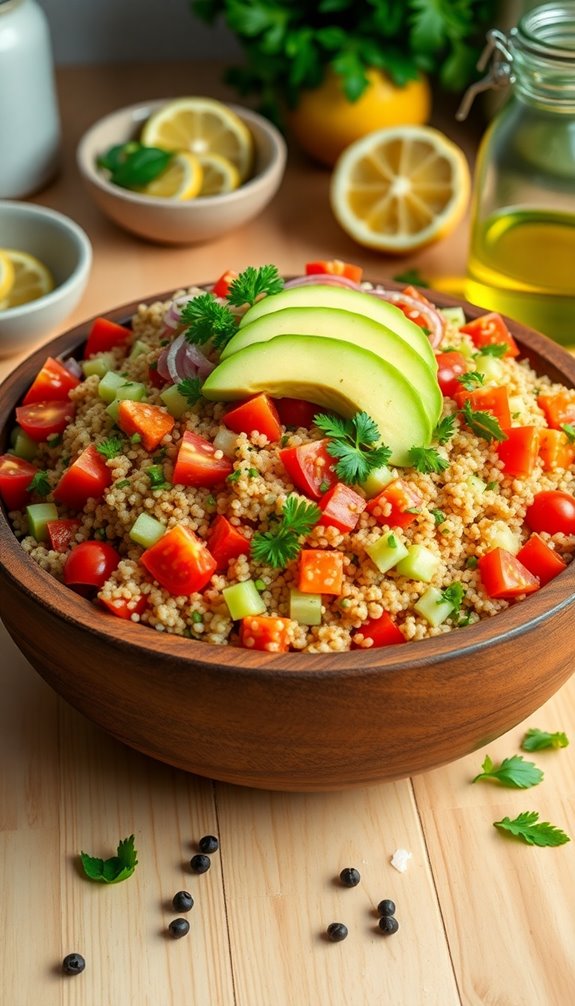When it comes to lunch, a healthy salad can be a game changer for your nutrition. Packed with leafy greens, colorful veggies, and protein-rich additions, this dish is both satisfying and beneficial. The right combination not only enhances flavors but also supports your overall health. Interested in how to put together a vibrant salad that's easy to prepare and nutritious? Let's explore the steps and options available to you.
Recipe Tips and Tricks
- Combine mixed leafy greens, cherry tomatoes, cucumber, bell pepper, and chickpeas for a colorful, nutrient-rich salad base.
- Dress with olive oil and lemon juice for a simple, flavorful dressing that enhances taste.
- Add sliced avocado, red onion, and nuts to boost flavor, texture, and healthy fats.
- Prepare ingredients in advance and store separately to maintain freshness and prevent sogginess.
- Aim for a two-cup serving size to ensure a balanced and satisfying lunch option.
How To Make It – Recipe
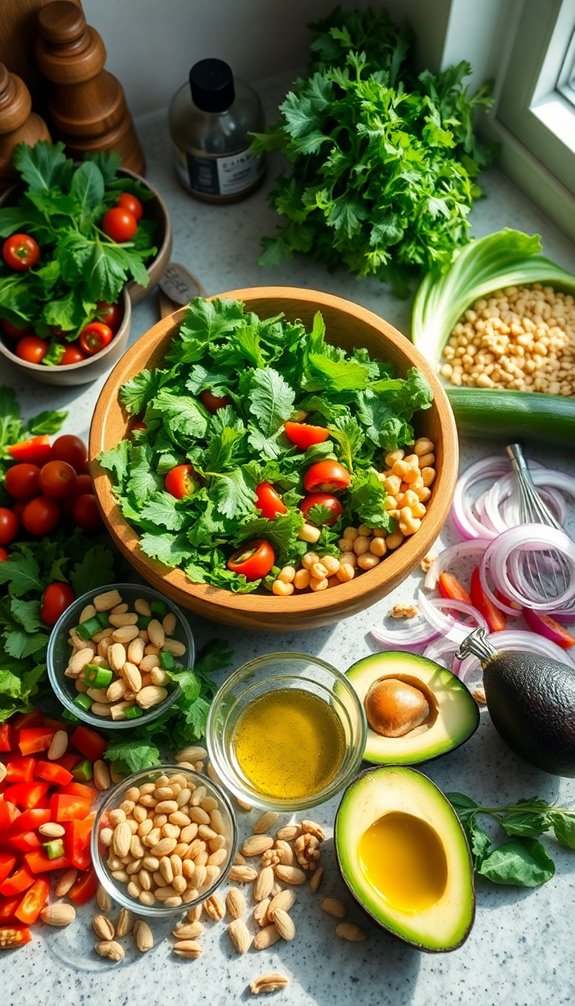
To make a healthy salad that's both delicious and nourishing, start by selecting a variety of fresh vegetables and greens. Leafy greens like spinach, arugula, or romaine provide a nutritious base, while colorful vegetables such as bell peppers, cucumbers, and cherry tomatoes add both flavor and visual appeal.
Consider incorporating some protein sources like chickpeas, grilled chicken, or tofu to make the salad more filling. Don't forget to add healthy fats, such as avocado or nuts, to enhance the texture and taste of your dish.
Once you have your ingredients prepared, it's time to create a simple yet tasty dressing. A mixture of olive oil, lemon juice, salt, and pepper works wonderfully to bring all the flavors together. You can also experiment with different herbs and spices to customize your dressing based on your preferences. Fresh and flavorful salads are an excellent way to incorporate more nutrients into your diet.
With everything prepped, you'll be ready to assemble a vibrant and healthy salad that can be enjoyed as a meal or a side dish.
Ingredients:
- 4 cups mixed leafy greens (spinach, arugula, romaine)
- 1 cup cherry tomatoes, halved
- 1 cucumber, diced
- 1 bell pepper, diced
- 1 cup cooked chickpeas (or protein of your choice)
- 1 avocado, sliced
- ¼ cup red onion, thinly sliced
- ¼ cup nuts (almonds, walnuts, or sunflower seeds)
- 3 tablespoons olive oil
- 1 tablespoon lemon juice
- Salt and pepper to taste
In a large mixing bowl, combine the leafy greens, cherry tomatoes, cucumber, bell pepper, chickpeas, avocado, and red onion.
In a separate small bowl, whisk together the olive oil, lemon juice, salt, and pepper to create the dressing. Drizzle the dressing over the salad and toss gently to combine all the ingredients, ensuring everything is evenly coated.
When preparing your healthy salad, feel free to get creative with your ingredients! You can add seasonal vegetables or fruits for a unique twist.
Additionally, if you're making the salad in advance, consider keeping the dressing separate until you're ready to serve to prevent the greens from wilting. For a burst of flavor, herbs like basil, cilantro, or parsley can also be added, making the salad even more invigorating. Enjoy your healthy creation!
Cooking Steps
To create a delicious salad, start by washing and chopping your vegetables to guarantee they're clean and fresh. It's important to include a variety of colors and textures for a nutritious salad that not only looks appealing but also provides a range of vitamins and minerals. Next, mix in your choice of dressing and toss everything together for even flavor distribution. Finally, add your preferred protein, top with nuts or seeds, and garnish with fresh herbs for an extra burst of taste.
Step 1. Wash and Chop Vegetables
Before diving into assembling your salad, it's essential to wash and chop your vegetables properly to assure freshness and flavor.
Rinse leafy greens and veggies under cold water to remove dirt and pesticides.
Use efficient chopping techniques—like the claw grip for safety—to create uniform pieces, maximizing vegetable benefits.
This guarantees even dressing coverage and enhances the overall taste and texture of your nutritious meal.
Step 2. Add Dressing and Toss
Once your vegetables are prepped, it's time to add the dressing and toss everything together.
Choose from various dressing options like balsamic vinaigrette or lemon olive oil for flavor.
Use tossing techniques such as the "lift and drop" method to guarantee even coverage, preventing sogginess.
This step enhances taste and guarantees each bite is nutritious and satisfying.
Enjoy your beautifully dressed salad!
Step 3. Add Protein of Choice
As you prepare to elevate your salad, adding a protein of your choice can greatly enhance its nutritional value and keep you feeling full longer.
Consider lean chicken, chickpeas, or tofu as excellent protein sources. These options not only provide essential nutrients but also contribute to flavor enhancement, making your salad a satisfying and delicious meal that fuels your body effectively.
Step 4. Top With Nuts or Seeds
Adding a handful of nuts or seeds can greatly boost the flavor and texture of your salad. Options like almonds, walnuts, or sunflower seeds not only add crunch but also provide essential nutrients.
The nut benefits, such as healthy fats and protein, enhance satiety and overall nutrition. Choose your favorite topping options to personalize your dish while elevating its health profile.
Step 5. Garnish With Fresh Herbs
To elevate your salad's flavor even further, garnishing with fresh herbs can make a significant difference.
Herbs like basil, cilantro, and parsley not only enhance flavor but also offer numerous health benefits, including antioxidants and anti-inflammatory properties.
Just sprinkle a handful on top before serving, and enjoy the flavor enhancement and added nutrition that fresh herbs bring to your meal.
Substitution Suggestions
When you're looking to customize your healthy salad, consider simple substitutions that can enhance flavor and nutrition.
Opt for quinoa instead of couscous for grain options, or swap out traditional lettuce for kale as a vegetable replacement.
You can also try chickpeas for protein variations, use yogurt-based dressing alternatives, and explore flavor swaps like adding citrus zest for a fresh kick. Additionally, incorporating fresh herbs can truly elevate the overall taste and nutritional profile of your salad.
Serving Suggestions
After customizing your salad with flavorful substitutions, it's time to contemplate how to serve it for maximum enjoyment.
Consider ideal salad pairings, such as whole grains or lean proteins, to boost nutrition. Aim for a serving size of about two cups to keep portions balanced. Including healthy lunch options can also enhance the flavor and variety of your meal.
This way, you'll savor every bite while ensuring you're meeting your dietary needs effectively. Enjoy your nutritious creation!
Make-Ahead and Storage
Although preparing salads in advance can save you time during busy weekdays, proper make-ahead strategies are crucial for maintaining freshness and flavor.
For effective meal prep, store ingredients separately; keep greens in airtight containers and dressings in small jars. Incorporating easy meal prep ideas can also help streamline your process and enhance variety.
When ready to eat, combine them to avoid sogginess. Following these storage tips guarantees your salad remains crisp and delicious throughout the week.
Nutrition Facts(per serving)
Understanding the nutrition facts of your salad can help you make informed choices that align with your dietary goals.
Each serving typically contains about 200 calories, making it a low-caloric content option. Packed with vitamins A, C, and K, your salad delivers essential vitamin benefits that support immune function and bone health. Additionally, incorporating healthy ingredients can enhance the nutritional profile of your meal.
This balanced meal promotes overall well-being while keeping you satisfied.
Final Thoughts
As you explore the world of healthy eating, remember that incorporating salads into your diet can be a simple yet effective way to boost your nutrition. The salad benefits are numerous, including improved digestion and increased vitamin intake. Additionally, adding a variety of colorful vegetables can enhance the nutritional value and flavor of your salads. By practicing meal prep, you'll save time and guarantee you always have a nutritious option on hand. Enjoy the journey to better health!
Recipe FAQs
Can I Add Fruits to My Salad for Sweetness?
Absolutely, you can add fruits to your salad for sweetness! Combining fruits like berries or citrus with crunchy greens enhances salad textures and boosts flavor, creating a delicious balance that's both invigorating and nutritious.
What Dressings Pair Well With a Healthy Salad?
When choosing dressing types for your salad, consider vinaigrettes for tanginess, creamy dressings for richness, or citrus-based options for brightness. Each brings unique flavor profiles, enhancing your salad while maintaining its healthy appeal.
How Can I Make My Salad More Filling?
To make your salad more filling, add grains like quinoa or farro, and incorporate protein sources such as chickpeas, grilled chicken, or tofu. These additions boost satiety and nutritional value, keeping you satisfied longer.
Are There Vegan Protein Options for Salads?
You can enhance your salad with vegan protein by adding tofu alternatives, chickpea options, lentil toppings, quinoa additions, or tempeh choices. Each option boosts nutrition and keeps your meal satisfying and delicious.
Can I Use Canned Vegetables in My Salad?
Sure, you can use canned vegetables in your salad. They offer convenience, enhance texture variations, and provide nutritional benefits. Just remember, they're not gourmet, but hey, who needs a Michelin star for lunch? Enjoy!

